Acer Aspire 5745DG Review
Acer Aspire 5745DG
With a 120Hz display and Nvidia's wireless shutter glasses, this affordable 15.6in laptop gives you 3D on the go.

Verdict
Key Specifications
- Review Price: £789.99
3D is the latest trend. It’s a standard feature on the majority of high-end TVs, with the most recent example being the stunning 21:9 Philips Cinema 58PFL9955H. As one would expect, it can also be found on monitors. In fact, we reviewed one of the first of these – Zalman’s M2020W Trimon 3D – back in 2008. Inevitably, 3D has also made its way to laptops, and today we’re looking at Acer’s 15.6in Aspire 5745DG, which comes with a 3D-capable screen and Nvidia-branded glasses.
So how is it different from an ‘ordinary’ 2D laptop? The main ingredient is that its display uses a 120Hz LCD panel. In combination with active shutter glasses (not the passive ones you get in the cinema), this gives you a 60Hz 3D image, as with stereoscopic 3D each eye is alternatively shown a specifically-tailored image.
Since the 5745DG sports an Nvidia GeForce GT 425M graphics card, it makes sense that Acer has gone with the graphics company’s well-established 3D Vision solution. This consists of a pair of rechargeable shutter glasses and a built-in infra-red transmitter, which you can read about in our 3D Vision review. The disadvantage here is that you won’t be able to hook the transmitter up to your desktop PC, but it also means you don’t have to carry around a dongle and it leaves an extra USB port free.
D glasses for Acer Aspire 5745DG laptop use.” width=”300″ height=”133″ class=”align size-medium wp-image-202607″>
Aside from its 3D credentials, the basic specification of the 5745DG isn’t all that amazing, residing at the high end of average. This is hardly surprising as Acer had to compromise somewhere to hit a sub-£800 price point whilst offering an adequately powerful machine with a 120Hz panel and a 3D kit that usually costs over £100 on its own.
Nevertheless, a dual core Intel Core i3 370M running at 2.4GHz should be fast enough to easily cope with the average consumer’s maximum workload. It’s backed by the usual 4GB of DDR3 RAM, which a 64-bit copy of Windows 7 Home Premium will make full use of. Permanent storage is handled by a 320GB drive, though unlike the new Dell XPS 17 it’s of the slower 5,400rpm variety. 
Also unlike Dell’s XPS there’s no Optimus, Nvidia’s clever graphics switching technology – so despite the CPU featuring integrated, frugal graphics, you’re restricted to the more power-hungry, dedicated Nvidia card even when on battery. The GeForce GT 425M has 1GB of DDR3 memory, and performance-wise should cope just fine with CUDA-accelerated applications, 3D video and light 3D gaming.
Connectivity on the Aspire 5745DG is mediocre. Those for whom the 320GB of internal storage isn’t enough won’t be pleased by the lack of eSATA or USB 3.0, and there’s no ExpressCard slot either, so you can’t add these on. Otherwise it’s business as usual, with VGA and HDMI (of the 3D-compatible 1.4 variety) for video, 3.5mm headphone and microphone jacks for audio, and four fairly well-spaced USB 2.0 ports for data. 
For networking you have the choice between Gigabit Ethernet or Wi-Fi N, though Bluetooth doesn’t make the cut. A memory card reader takes the usual suspects (SD/HC, MMC, MS Pro/Duo) and finally a DVD-Rewriter is on hand for optical media.
While it might have been necessary to keep the price down, the lack of a Blu-ray drive means that most (legal) stereoscopic 3D movies are off the menu. Of course you can still play these if you buy an external Blu-ray drive, but we can only imagine there will be quite a few consumers frustrated with this Acer’s inability to play commercial high definition 3D discs ‘out of the box’. 
Getting to design, when closed the 5745DG presents a glossy black lid with a subtle pinstripe pattern and even subtler silver sparkles. While it doesn’t help much with disguising all those nasty fingerprints the laptop will doubtless accumulate in no time at all, it’s certainly not unattractive. 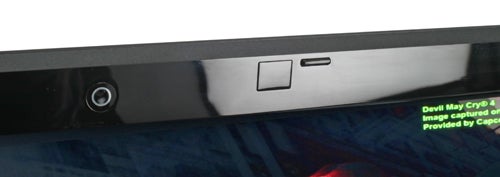
Opening the machine up reveals a more sensible interior, for though the screen’s bezel is glossy (with the 1.3 megapixel webcam and Nvidia receiver neatly integrated), the palm rest area sports a thin veneer of brushed aluminium. The gunmetal grey colour works quite well with the matte black keyboard and its piano black surround, offset by blue power and status LEDs.
However, what you’re most likely to notice – and indeed one of the 5745DG’s distinguishing features, though not necessarily in a good way – is its huge nine-cell battery, which protrudes enough at the bottom to put the laptop at quite an angle. Some might prefer this for typing, but it does make it very difficult to fit the machine in a bag or sleeve with the battery attached. 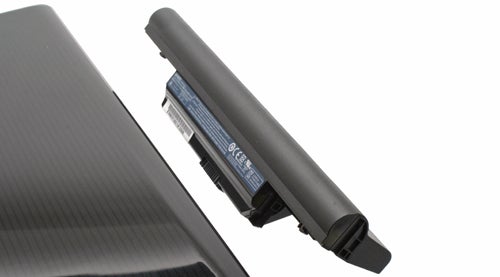
Build quality throughout is very good, with no unwanted flex, creak or poor fittings, and solid hinge action. The laptop generally stays very quiet in use, and even under load emits only a light hum that shouldn’t distract too much.
Thanks to its large chassis, Acer has managed to fit a full-sized keyboard with number pad on the 5745DG. Layout is spot-on with intelligent shortcut placement, and key feedback is nice and crisp with more travel than you would expect from such a shallow effort. Our only gripe is that the key size and close spacing (with almost no gaps) makes it too easy to hit the wrong key from time to time. 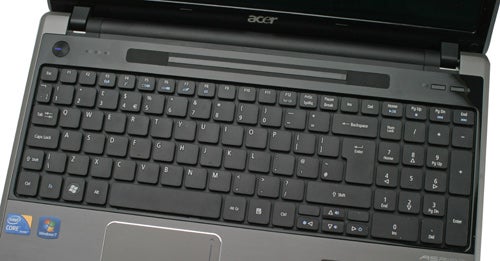
As is pretty much standard these days, the large touchpad supports multi-touch. It’s well-delineated, sensitive and pleasantly smooth. Integrated into a single rocker switch, its buttons feature only a small dead zone, and though they’re a little on the stiff side they’re not unpleasant to use.
The optical drive eject button and Acer’s signature, customisable Application Launch button can be found above the keyboard, and are both welcome additions.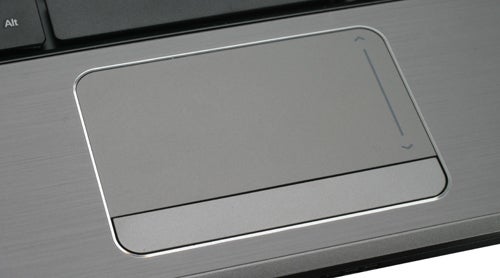
We’ll get to the display’s 3D performance in a bit, but the plain fact of the matter is that with gaming being the only sector in which a large volume of compatible content is available (for now), you’ll probably spend most of your time in good old 2D.
Thankfully, the 15.6in, 1,366 x 768 TN panel performs surprisingly well. Most impressive is its contrast, showing all the detail in even the darkest films and games (though inevitably at the expense of white purity). This is one of the more important factors in an entertainment-oriented screen and we’re glad Acer got it right. 
Colours are decent and sharpness is good, with its LED backlighting reasonably even. Undoubtedly helped by its 120Hz refresh rate, motion is smooth and there’s not a hint of ghosting over fast action.
The only fly in the ointment – aside from possible reflections in the screen’s glossy coating – is that there is some contrast shift even from the ‘ideal’ viewing angle, and viewing angles in general aren’t a particular strong point. Of course, with 3D you need to be positioned fairly centrally to get the full benefits anyway. 
Unfortunately the speakers don’t live up to the screen’s performance despite their Dolby Home Cinema V3 processing. Mind you, they’re by no means poor, with not a hint of distortion and decent clarity at the high end. However, they do lack the maximum volume and punch of better models on similarly-sized machines, such as the Bang & Olufsen-equipped Asus N53JN.
For everyday use, the Aspire 5745DG 2.4GHz Core i3 is more than up to the task. It will handle most tasks with ease, and certainly won’t be a bottleneck in most games.
Gaming is certainly a target audience with a 400-series GeForce, and for regular ‘2D’ gaming it holds up fairly well. Casual games are certainly no problem, and even Stalker: Call of Pripyat was playable at the screen’s native resolution. 
However, more challenging fare like Crysis is definitely off the menu, as evidenced by it managing only 18.7 frames per second (fps) on high detail (incidentally an almost identical score to the Dell XPS 17, which sported a GeForce 435M). Dropping detail down to Medium resulted in a more playable 32.4fps average, but for us that’s a compromise too far. 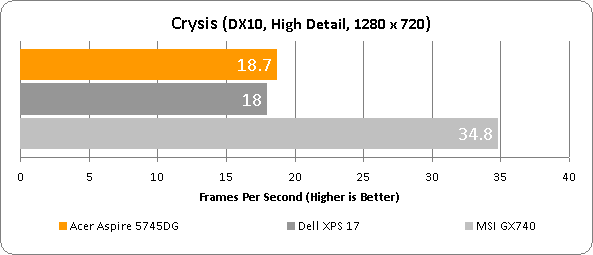
Unsurprisingly, the 9,000mAh/99Wh battery (one of the highest capacities we’ve come across) ensures that this laptop will last a relatively long time on the go, despite exclusively relying on power-hungry dedicated graphics. It managed an impressive five hours and 10 minutes in our Productivity test, and an even more remarkable three hours and 40 minutes playing back optical media with the screen at full brightness. We can but imagine how long it would last if it used Optimus.
These are excellent results for any 15.6in laptop, but especially for one not utilizing Intel’s weak yet frugal integrated graphics. Even the longest 3D films shouldn’t be a problem, and gaming on the go is certainly a viable option – especially since, aside from its awkward shape, the 3kg 5745DG is not too heavy either and offers a reasonable 379 x 250mm footprint.
Once you’ve charged the active shutter glasses using the provided mini-USB cable, setting up 3D on the Aspire 5745DG is fairly painless. Acer provides a selection of still images and trailers to have a play with the effect, appropriately called 3D Demo. One criticism here is that its media player doesn’t have ‘3D mode’ activated by default, which might lead some to think there’s a problem with the glasses.
You also need to realize that the ‘Enable stereoscopic 3D’ box needs to be ticked in Nvidia’s driver. As this is something you’ll want to turn on and off depending on how demanding the content is (the GeForce GT 425M will struggle to run many demanding games even in 2D), it would also have been nice to have a dedicated shortcut or even a physical button.
D glasses for Acer Aspire 5745DG laptop.” width=”300″ height=”133″ class=”align size-medium wp-image-202692″>
Ergonomically the Nvidia glasses are quite comfortable for extended periods, even if you’re already wearing spectacles. They do darken your view considerably, but you can always turn up the laptop screen’s brightness to counteract this. Avoid using them near fluorescent lighting, as this will cause severe flicker – in fact, they’re best used in a darkened room. 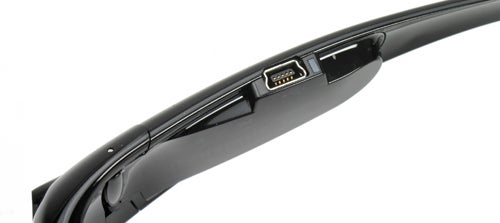
With this in mind, and when viewing from the right angle, the 3D effect can be genuinely impressive. Despite inherent LCD issues like crosstalk and being slightly more tiring on the eyes, it’s definitely worth the ‘hassle’. With the right material, it lends both games and video extra immersion – though nothing near the experience a bigger screen like the 50in Samsung PS50C6900 will provide. A depth slider on Nvidia’s control panel also lets you determine the extent of the effect in games.
The biggest disadvantage to 3D in the case of Acer’s 5745DG is that its GT 425 graphics card simply can’t cope with running intensive games in stereoscopic mode, as it effectively needs to render each frame twice. As an example, in our very light TrackMania Nations Forever test, it dropped from 80.9 frames per second (fps) in ‘2D mode’ to 46.5fps with stereoscopic 3D enabled. In more demanding titles like Stalker: Call of Pripyat it was the difference between playable and completely unplayable.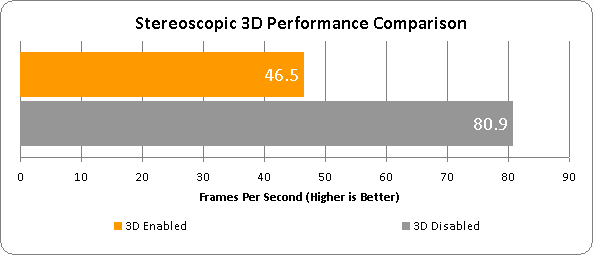
This puts the 5745DG in a difficult position. It’s not ideal for 3D films because it lacks a Blu-ray drive, and not great for 3D games because it lacks the graphics grunt to run most of them at decent resolutions and detail levels. Thankfully, at £790 you don’t pay an absurdly huge premium for the extra dimension, and if 3D is your thing those titles that do work will make it worth it.
However, if you already have a decent desktop PC sporting capable Nvidia graphics – especially one with Blu-ray – you should consider a 3D Vision set and 3D monitor before buying this compromised machine. If, on the other hand, you’re into games but not 3D, the MSI GX740 will let you play far more demanding games the regular way for only a slight premium. 
The Acer’s only remaining advantage lies in its excellent battery life, so if you’re looking for modest gaming on the go there’s little that will beat it.
Verdict
Acer’s Aspire 5745DG is an affordable entry into 3D and offers impressive battery life, but while it might be perfect for some, in general a few too many corners have been cut to completely win us over.
How we test laptops
Unlike other sites, we test every laptop we review thoroughly over an extended period of time. We use industry standard tests to compare features properly. We’ll always tell you what we find. We never, ever, accept money to review a product.
Trusted Score
Score in detail
-
Performance 7
-
Design 7
-
Value 8
-
Features 8
-
Battery Life 8
Processor, Memory & Storage
| Processor | Intel Core i3 M370 |
| Processor Speed Standard (Gigahertz) | 2.4GHz |
| Memory (RAM) (Gigabyte) | 4GB |
| Hard Disk Drive (HDD) (Gigabyte) | 320GB |
| Hard Disk Drive Speed (RPM) | 5400rpm |
| Solid State Drive (SSD) | No |
| DVD Optical Drive | DVD Rewriter |
Graphics & Sound
| Graphics | Nvidia GeForce GT 425M |
| Display (Inch) | 15.6in |
| Display Finish | Glossy |
Communication
| Ethernet | Gigabit |
| Mobile Broadband/3G | No |
| Bluetooth | No |
| Webcam | SD |
Connectivity
| Audio Connections | 2x 3.5mm (headphone and microphone) |
Software
| Operating System | Windows 7 |
Other
| Battery life (Hour) | 310hr |
| Special Features | 120Hz Display, Wireless stereoscopic 3D Vision glasses included |
| Battery | 9,000mAh/99Wh |
| Type | Other Laptop |
Physical Specifications
| Weight (With Battery) (Kilogram) | 3kg |
| Dimensions Width (Millimeter) | 379mm |
| Depth (Millimeter) | 250mm |
Data
| Card Reader | SD/HC/XC, MMC, MS/Pro/Duo |

